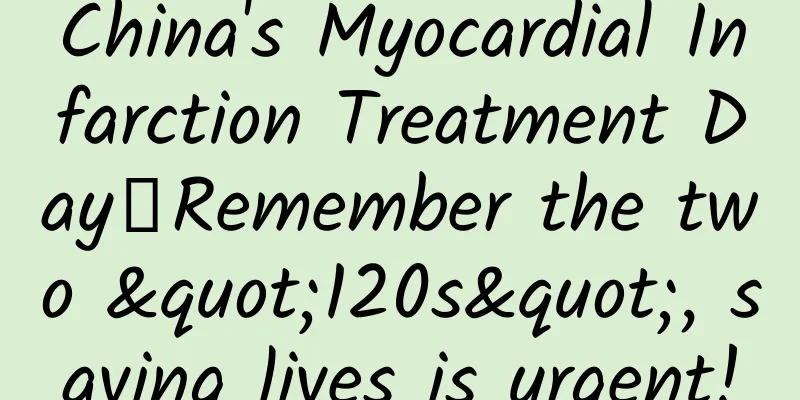China's Myocardial Infarction Treatment Day丨Remember the two "120s", saving lives is urgent!

|
November 20th of each year is the Myocardial Infarction Treatment Day in my country. This is a public action initiated by the industry, supported by the government, and participated in by the whole society to pay attention to the treatment of acute myocardial infarction in China. Acute myocardial infarction poses a great threat to national health, and its mortality rate is extremely high, so it is known as the "number one killer". Only by taking prompt treatment measures at the first time can the success rate of treatment be significantly improved and the patient's life be saved. On November 16, a unique roundtable interview between doctors and patients was held at the Xiangjiang Heart Failure Forum hosted by Hunan Provincial People's Hospital. Mr. Luo shared his experience of receiving treatment. "If I had to choose again, I would choose emergency surgery immediately, because I didn't realize the severity of my condition at the time, so I refused the surgery at first." Mr. Luo said in the interview. "Mr. Luo, 59 years old, was admitted to the hospital for emergency treatment due to chest tightness for 12 hours. According to the results of biochemical tests and electrocardiogram, Dr. Lian from the Department of Cardiology initially diagnosed him with acute extensive anterior wall myocardial infarction and strongly recommended emergency surgery immediately. However, the patient felt that he was in good physical condition and refused emergency surgery many times. In view of the severity of the disease, he would face extremely high life-threatening risks if he did not undergo surgery. I decided to talk to the patient again and the patient finally agreed to undergo surgery. While sending the patient to the operating room, he suddenly developed acute pulmonary edema and lost consciousness. We took prompt action, using a ventilator and supporting aortic balloon counterpulsation technology to maintain his vital signs, and performed coronary angiography. The results showed that the patient's anterior descending branch and right coronary artery were completely occluded, accompanied by diffuse plaques, stenosis and calcification, and the stenosis of the circumflex branch was as high as 90%. We immediately opened the occluded blood vessels, and fortunately, the rescue was timely and saved his life. At present, Mr. Luo is taking medicine as prescribed by the doctor, insisting on regular exercise, and his life has become colorful." Director Pan Hongwei said when recalling this experience. Time is myocardium, time is life! In view of the suddenness, high risk and high lethality of acute myocardial infarction, two important treatment goals have been set: one is to emphasize "call 120" to the public, because when a myocardial infarction occurs, it is crucial to get timely and effective treatment through the 120 ambulance; the other is to emphasize that "within 120 minutes" the blood vessels blocked by acute myocardial infarction must be opened for medical institutions and doctors. These two "120" together constitute the core theme of the Myocardial Infarction Treatment Day. 1. What is acute myocardial infarction? Acute myocardial infarction is a pathological condition in which blood flow is interrupted due to the occlusion of the coronary artery, which in turn causes local necrosis of the myocardium due to prolonged ischemia. To use an analogy, the coronary artery is like a water pipe for irrigating a field, and the myocardial cells are like the crops in the field. Once the water pipe is blocked, the crops will begin to wither in the early stages, and if they do not get water for a long time, they will inevitably die. Therefore, myocardial infarction is essentially the death process of myocardial cells. Since myocardial cells cannot regenerate, they cannot be restored once they die, which means that emergency treatment for myocardial infarction must be done every second. In my country, cardiovascular disease has become the leading cause of death among residents, claiming the lives of about 4 million people each year, with an average of about 10,000 people dying every day from cardiovascular diseases such as acute myocardial infarction. It is worth noting that among these cases, up to 70% to 80% of patients have a chance to survive if they receive timely and effective treatment, and most patients can return to normal life after treatment. 2. What is a chest pain center? The chest pain center is a medical model that achieves holistic treatment from pre-hospital, in-hospital and post-hospital to the greatest extent possible. It promotes the connection between the pre-hospital and hospital from the onset of the patient to emergency transfer. The chest pain center needs to improve its capabilities. It is not only able to save patients, but also to dissolve thromboses and perform interventional treatments when myocardial infarction occurs. More importantly, it needs to be done quickly, well, efficiently and effectively. If blood vessels are opened early, the mortality rate will be significantly reduced. Therefore, the chest pain center is built in a standardized and systematic way, combining the most optimized path and the most advanced technology to open up a green channel for the rapid treatment of chest pain-related diseases such as acute myocardial infarction. The prevention and treatment of acute chest pain diseases such as acute myocardial infarction is a complex systematic project, involving multiple links such as primary disease prevention, emergency treatment and secondary prevention. Therefore, establishing a scientific and standardized chest pain center system is an important measure to improve the current status of cardiovascular disease treatment. The Chest Pain Center of Hunan Provincial People's Hospital was established in 2016 and is the first chest pain center certified in Hunan Province. It is the chairman unit of the Hunan Chest Pain Alliance, the Medical Quality Control Center of Hunan Chest Pain Center, and the National Health Commission's Coronary Intervention Training Base. It has carried out ECMO-supported coronary PCI, coronary artery bypass grafting + coronary PCI (one-stop) and other complex coronary artery lesion treatments. Let us work together to protect every beating moment. Please remember, if you have a heart attack, call 120, and if you have a chest pain, call the chest pain center for help! Hunan Medical Chat Special Author: Wang Dan, Department of Cardiology, Hunan Provincial People's Hospital Follow @湖南医聊 to get more health science information! (Edited by Wx) |
<<: [Medical Q&A] Is facial paralysis caused by cold wind?
>>: 【Medical Q&A】What are the common symptoms of facial paralysis? How to treat it?
Recommend
What is good to eat with bacon? Who should not eat bacon?
In our daily life, some people like to eat bacon ...
What are the treatments for uterine angioleiomyomas?
Tumors may occur in any part of the body, and the...
What is the reason for high alkaline phosphatase in pregnant women?
Many people will find that some pregnant women ha...
What is the reason why girls grow hair on their stomachs?
Having hair on the body is a very common phenomen...
I don't have my period and I'm not pregnant, what's going on?
Women after puberty will automatically have menst...
How long does it take for the wound to not hurt after a cesarean section?
Whether it is a caesarean section or a natural bi...
What bad habits cause clear vaginal discharge?
Nowadays, everyone knows that gynecological disea...
How to perform underarm odor surgery on girls?
Since medical technology has begun to develop, ma...
What should women eat before pregnancy preparation?
At present, more and more couples are beginning t...
I always want to poop during my period but can't
After your period, you want to defecate but can&#...
What should I do if my ovarian cyst ruptures? Avoid seeking medical treatment hastily
When a woman's ovarian cyst ruptures, she mus...
Well-known actor dies at the age of 42! This type of cancer is easily misdiagnosed and missed, so middle-aged and elderly people should be especially vigilant!
Recently, 42-year-old Hollywood actor Adan Canto ...
Why does menstruation always come early?
Menstruation is a normal physiological cycle for ...
There is little residue after the abortion
After medical abortion, there is a small amount o...
Can ovarian cysts cause amenorrhea?
Ovarian cyst is a common gynecological disease an...









